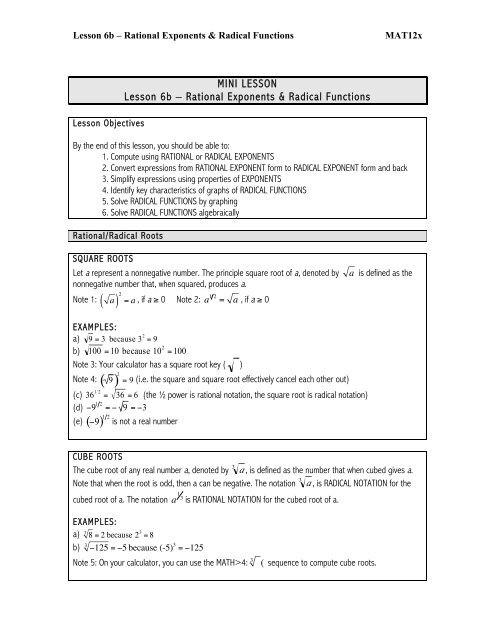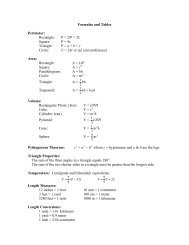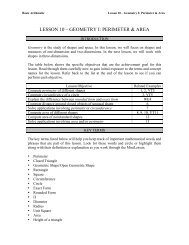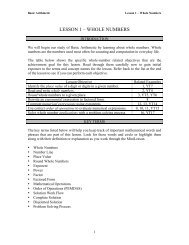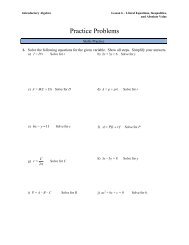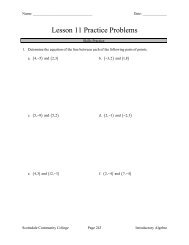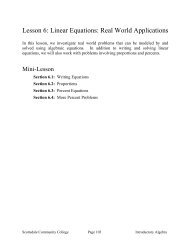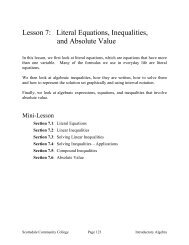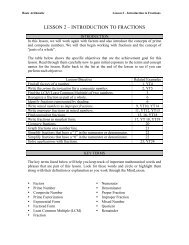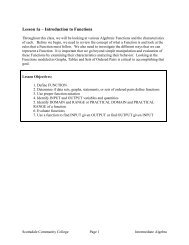MINI LESSON Lesson 6b – Rational Exponents & Radical Functions
MINI LESSON Lesson 6b – Rational Exponents & Radical Functions
MINI LESSON Lesson 6b – Rational Exponents & Radical Functions
You also want an ePaper? Increase the reach of your titles
YUMPU automatically turns print PDFs into web optimized ePapers that Google loves.
<strong>Lesson</strong> <strong>6b</strong> <strong>–</strong> <strong>Rational</strong> <strong>Exponents</strong> & <strong>Radical</strong> <strong>Functions</strong><br />
MAT12x<br />
<strong>Lesson</strong> Objectives<br />
<strong>MINI</strong> <strong>LESSON</strong><br />
<strong>Lesson</strong> <strong>6b</strong> <strong>–</strong> <strong>Rational</strong> <strong>Exponents</strong> & <strong>Radical</strong> <strong>Functions</strong><br />
By the end of this lesson, you should be able to:<br />
1. Compute using RATIONAL or RADICAL EXPONENTS<br />
2. Convert expressions from RATIONAL EXPONENT form to RADICAL EXPONENT form and back<br />
3. Simplify expressions using properties of EXPONENTS<br />
4. Identify key characteristics of graphs of RADICAL FUNCTIONS<br />
5. Solve RADICAL FUNCTIONS by graphing<br />
6. Solve RADICAL FUNCTIONS algebraically<br />
<strong>Rational</strong>/<strong>Radical</strong> Roots<br />
SQUARE ROOTS<br />
Let a represent a nonnegative number. The principle square root of a, denoted by<br />
nonnegative number that, when squared, produces a.<br />
Note 1: ( a) 2 = a , if a ≥ 0 Note 2: a 1 2 = a , if a ≥ 0<br />
a is defined as the<br />
!<br />
!<br />
!<br />
!<br />
!<br />
EXAMPLES:<br />
a) 9 = 3 because 3 2 = 9<br />
b) 100 = 10 because 10 2 = 100<br />
Note 3: Your calculator has a square root key ( )<br />
Note 4: ( 9) = 9 (i.e. the square and square root effectively cancel each other out)<br />
(c) 36 1 2 = 36 = 6 (the ½ power is rational notation, the square root is radical notation)<br />
(d) "9 1 2 = " 9 = "3 !<br />
! (e) "9<br />
( ) 1 2 is not a real number<br />
CUBE ROOTS<br />
3<br />
The cube root of any real number a, denoted by a , is defined as the number that when cubed gives a.<br />
3<br />
Note that when the root is odd, then a can be negative. The notation a , is RADICAL NOTATION for the<br />
cubed root of a. The notation a 1 3<br />
is RATIONAL NOTATION for the cubed root of a.<br />
!<br />
EXAMPLES:<br />
!<br />
3<br />
a) 8 = 2 because 2 3 = 8<br />
3<br />
b) !125 = !5 because (-5) 3 = !125<br />
Note 5: On your calculator, you can use the MATH>4: 3 ( sequence to compute cube roots.
<strong>Lesson</strong> <strong>6b</strong> <strong>–</strong> <strong>Rational</strong> <strong>Exponents</strong> & <strong>Radical</strong> <strong>Functions</strong><br />
MAT12x<br />
THE NTH ROOT OF a<br />
n<br />
a = a 1 n , the nth root of a. The number a, called the radicand, must be nonnegative if n, called the<br />
index, is even.<br />
!<br />
EXAMPLES:<br />
4<br />
a) 81 = 3<br />
b) (!32) 1 5 = !2<br />
c) !225 1 4 " !3.9<br />
Note 5: On your calculator, you can use the MATH>5: sequence to compute nth roots. You can also<br />
use the ^ key to raise to fractional powers. Recommendation is to put any fractional power in ( ).<br />
4<br />
d) !1296 is not a real number<br />
RATIONAL EXPONENTS<br />
EXAMPLES:<br />
( ) 2 3 3<br />
= !27<br />
a) !27<br />
a p q =<br />
( ) 2 = (!3) 2 = 9<br />
b) 16 3 4 4<br />
= ( 16) 3 = 2 3 = 8<br />
c) 8 !2 3 = 1<br />
8 = 1<br />
2 3 3<br />
8<br />
( ) 2 = 1 2 2 = 1 4<br />
q<br />
!<br />
a p<br />
x<br />
q<br />
= ( a) p where a ≥ 0 if q is even.<br />
Problem 1<br />
MEDIA EXAMPLE <strong>–</strong> COMPUTE WITH RATIONAL/RADICAL EXPONENTS<br />
a) 81 =<br />
!<br />
3<br />
27<br />
b) =<br />
[Note: Before you do part c, press MODE then change a+bi to REAL by using your arrow then ENTER<br />
keys.]<br />
c)<br />
"16 =<br />
d) (!125) 1 3 =<br />
!<br />
e)<br />
25 3 2 =<br />
!<br />
f)<br />
3 ("8) 2<br />
=<br />
!<br />
2
<strong>Lesson</strong> <strong>6b</strong> <strong>–</strong> <strong>Rational</strong> <strong>Exponents</strong> & <strong>Radical</strong> <strong>Functions</strong><br />
MAT12x<br />
Problem 2<br />
MEDIA EXAMPLE <strong>–</strong> SIMPLIFY USING PROPERTIES OF EXPONENTS<br />
Simplify each of the following using properties of exponents.<br />
a)<br />
x 1 2 x 2 3 =<br />
!<br />
b)<br />
x 3<br />
x 1 3 =<br />
c) 10x2 y 5<br />
2x !3<br />
d)<br />
5 !1 z<br />
x !1 z !2<br />
e) -3(x 0 <strong>–</strong> 4y 0 )<br />
f) (4x 2 y 3 )(3x -3 y -2 )<br />
g)<br />
4x !2 y !3<br />
( ) 5x 3 y !2<br />
( )<br />
6x 2 y !3 z !3<br />
3
<strong>Lesson</strong> <strong>6b</strong> <strong>–</strong> <strong>Rational</strong> <strong>Exponents</strong> & <strong>Radical</strong> <strong>Functions</strong><br />
MAT12x<br />
Problem 3<br />
YOU TRY <strong>–</strong> COMPUTE WITH RATIONAL/RADICAL EXPONENTS<br />
Compute each of the following showing as much work as possible. Check results using your calculator.<br />
a) 36<br />
3<br />
b) !64<br />
c) 16 3 2<br />
d) (!25) 1 2<br />
3<br />
e) ( 27) 4<br />
Problem 4<br />
YOU TRY <strong>–</strong> SIMPLIFY USING PROPERTIES OF EXPONENTS<br />
Simplify each of the following using properties of exponents. Remember to write all final results with positive<br />
exponents only. Show as much work as possible.<br />
a) x 1 4 x 3 7 =<br />
b)<br />
x 2<br />
x 1 4 =<br />
c) (!2x 3 y !4 )(3x !4 y 6 )=<br />
d)<br />
3x !3 y !2<br />
( ) 4x 2 y !1<br />
( )<br />
6x 4 y 2 z !5 =<br />
4
<strong>Lesson</strong> <strong>6b</strong> <strong>–</strong> <strong>Rational</strong> <strong>Exponents</strong> & <strong>Radical</strong> <strong>Functions</strong><br />
MAT12x<br />
RADICAL FUNCTIONS <strong>–</strong> KEY CHARACTERISTICS<br />
<strong>Radical</strong> <strong>Functions</strong><br />
A basic radical (square root) function is a function of the form<br />
f (x) = p(x)<br />
where p(x) is a polynomial and p(x) ! 0 (remember that we cannot take the square root of negative<br />
numbers in the real number system).<br />
!<br />
DOMAIN<br />
• To determine the domain of f(x), you want to find the values of x such that p(x) ! 0 .<br />
X-INTERCEPT<br />
• To determine the x-intercept, solve the equation p(x) = 0.<br />
Y-INTERCEPT<br />
• To determine the y-intercept, determine the value for f(0). This means, plug 0 in for x and compute the<br />
result. You will not always have a y-intercept.<br />
Problem 5<br />
Graph f (x) =<br />
WORKED EXAMPLE <strong>–</strong> KEY CHARACTERISTICS OF RADICAL FUNCTIONS<br />
x ! 2 and determine y-intercept, x-intercept, and domain of f(x).<br />
To graph, input into Y1 the following: 2 nd >X^2 then x-2) so that Y1=<br />
window (Zoom 6) to get the graph below:<br />
(x ! 2) . Graph on the standard<br />
DOMAIN<br />
• Solve<br />
x " 2 # 0 to get<br />
x " 2. Therefore the domain is<br />
x " 2.<br />
X-INTERCEPT<br />
!• Solve x <strong>–</strong> 2 = ! 0 to get x = 2. The x-intercept ! is (2,0)<br />
Y-INTERCEPT<br />
• Determine f(0) =<br />
0 " 2 = "2 which is not a real number, so there is no y-intercept.<br />
!<br />
5
<strong>Lesson</strong> <strong>6b</strong> <strong>–</strong> <strong>Rational</strong> <strong>Exponents</strong> & <strong>Radical</strong> <strong>Functions</strong><br />
MAT12x<br />
Problem 6<br />
MEDIA EXAMPLE <strong>–</strong> KEY CHARACTERISTICS OF RADICAL FUNCTIONS<br />
Given the functions f (x) = 3! x and g(x) = x ! 3 , determine the domain and the x-intercept of<br />
each, and draw their graphs on the same axes.<br />
Problem 7<br />
YOU TRY <strong>–</strong> KEY CHARACTERISTICS OF RADICAL FUNCTIONS<br />
Given the function f (x) =<br />
function.<br />
2x !10 , determine the domain, the x-intercept, and draw a graph of the<br />
6
<strong>Lesson</strong> <strong>6b</strong> <strong>–</strong> <strong>Rational</strong> <strong>Exponents</strong> & <strong>Radical</strong> <strong>Functions</strong><br />
MAT12x<br />
SOLVE RADICAL EQUATIONS BY GRAPHING<br />
• Let y1 = one side of the equation<br />
• Let y2 = other side of the equation<br />
• Determine an appropriate window to see important parts of the graph<br />
• Use the intersection method<br />
• The x-value(s) of the intersection are your solutions<br />
• Note: If your graphs do not cross, then there is no intersection and no solution to the equation.<br />
Problem 8<br />
WORKED EXAMPLE <strong>–</strong> SOLVE RADICAL EQUATIONS BY GRAPHING<br />
Solve<br />
2x +1 = 3 graphically.<br />
Let Y1 =<br />
Let Y2 = 3<br />
2x +1<br />
Graph on the standard window (Zoom:6) then determine the intersection (seen below). Your solution is the<br />
!<br />
rounded x-value of the intersection which in this case is x = 4.<br />
Problem 9<br />
MEDIA EXAMPLE <strong>–</strong> SOLVE RADICAL EQUATIONS BY GRAPHING<br />
Solve the equation graphically: 2x +1 ! 5 = 0<br />
7
<strong>Lesson</strong> <strong>6b</strong> <strong>–</strong> <strong>Rational</strong> <strong>Exponents</strong> & <strong>Radical</strong> <strong>Functions</strong><br />
MAT12x<br />
SOLVE RATIONAL EQUATIONS ALGEBRAICALLY<br />
To solve SIMPLE radical equations algebraically (also called symbolically):<br />
• Isolate the radical part of the equation on one side and anything else on the other<br />
• Sometimes you will have radicals on both sides. That is ok.<br />
• Raise both sides of the equation to a power that will “undo” the radical (2 power to get rid of<br />
square root, 3 power to get rid of cubed root, etc…)<br />
• Solve for x.<br />
• Be sure x is part of the domain for the radical part of your equation by checking your result in the<br />
original.<br />
• Check your work using the graphing method if possible.<br />
Problem 10<br />
WORKED EXAMPLE <strong>–</strong> SOLVE RADICAL EQUATIONS ALGEBRAICALLY<br />
Solve<br />
2x +1 = 3 algebraically.<br />
First, square both sides to remove the square root. Then, isolate x.<br />
2x +1 = 3<br />
( 2x +1) 2 = 3 2<br />
2x +1 = 9<br />
2x = 8<br />
x = 4<br />
Very important: Check x = 4 in the original to be sure it works! Not all x’s obtained using the process above<br />
will check properly in your equation. If an x does not check, then it is not a solution.<br />
!!<br />
Check: 2(4)+1 = 9 = 3 checks!<br />
Problem 11<br />
MEDIA EXAMPLE <strong>–</strong> SOLVE RADICAL EQUATIONS ALGEBRAICALLY<br />
Solve 10<br />
x + 2 = 20 algebraically.<br />
8
<strong>Lesson</strong> <strong>6b</strong> <strong>–</strong> <strong>Rational</strong> <strong>Exponents</strong> & <strong>Radical</strong> <strong>Functions</strong><br />
MAT12x<br />
Problem 12<br />
YOU TRY <strong>–</strong> SOLVE RADICAL EQUATIONS GRAPHICALLY/ALGEBRAICALLY<br />
a) Solve the equation algebraically and graphically: 3 x ! 2 = 6 . Be sure to check your final result!<br />
b) Solve the equation algebraically and graphically: x +1 + 5 =1. Be sure to check your final result!<br />
9
<strong>Lesson</strong> <strong>6b</strong> <strong>–</strong> <strong>Rational</strong> <strong>Exponents</strong> & <strong>Radical</strong> <strong>Functions</strong><br />
MAT12x<br />
Problem 13<br />
WORKED EXAMPLE <strong>–</strong> SOLVE RADICAL EQUATIONS <strong>–</strong> MORE ADVANCED<br />
Solve the equation algebraically and check graphically:<br />
x + 6 = x . Be sure to check your final result!<br />
Since the radical is isolated, square both sides to remove the square root. Then, isolate x.<br />
x + 6 = x<br />
!<br />
( x + 6) 2 = x 2<br />
x + 6 = x 2<br />
0 = x 2 ! x ! 6<br />
x 2 ! x ! 6 = 0<br />
What we now have is a quadratic equation that we can solve using the methods of <strong>Lesson</strong> 5. The easiest<br />
and fastest way to work with this problem is through factoring. You can also use the Quadratic Formula or<br />
graphing.<br />
x 2 ! x ! 6 = 0<br />
CHECK:<br />
(x + 2)(x ! 3) = 0<br />
x + 2 = 0!!or x ! 3 = 0<br />
x = !2!!!or!!x = 3<br />
When x = -2<br />
!2 + 6 = !2<br />
!! 4 = !2<br />
!!!!2 " !2<br />
x = -2 does not check so is not a solution.<br />
When x = 3<br />
3+ 6 = 3<br />
!! 9 = 3<br />
!!!!3 = 3<br />
x = 3 checks so is a solution.<br />
Graphical Check: y1=<br />
x + 6,!y2 = x Window: Standard<br />
Using the Intersection Method, we obtain a verified<br />
solution of x = 3.<br />
10
<strong>Lesson</strong> <strong>6b</strong> <strong>–</strong> <strong>Rational</strong> <strong>Exponents</strong> & <strong>Radical</strong> <strong>Functions</strong><br />
MAT12x<br />
Prob 3: a) 6 b) -4 c) 64 d) not a real number e) 81<br />
YOU TRY - Answers<br />
Prob 4: a) x 19 28<br />
b) x 7 4<br />
c) !6y2<br />
x<br />
d)<br />
2z 5<br />
x 5 y 5<br />
Prob 7: Domain x ! 5 , x-intercept (5, 0)<br />
Prob 12: a) x=6 b) no solution<br />
11


